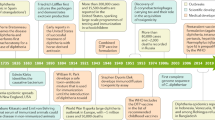Abstract
With the global immunization programme of children there is a progressive decline in the number of diphtheria cases. It is a disease commonly affecting the children caused by Corynebacterium diphtheriae usually affecting the mucous membrane of the nose, pharynx or larynx. Cutaneous diphtheria is a rare entity. We present a rare case of cutaneous diphtheria in a 15-year-old boy with nasal pharyngeal and laryngeal involvement. The patient developed anaphylactic reaction to antidiphtheritic serum (ADS) during treatment, all of which were managed successfully.
Similar content being viewed by others
References
Hart PE, Lee PY, Macallan DC, Wansbrough—Jones MH. Cutaneous and pharyngeal diphtheria imported from the Indian subcontinent. Post Grad Med J 1996;852:619–20.
Smith GR. Charles SF Easman Principles of bacteriology, virology and immunity. Topley and Wilson’s. 8th edn 1990. p. 57,69 and 71.
Park K. Parks Text Book of Preventive and Social Medicine. 15th edn. p. 127–8.
Efstratiou A, Engler KH, Mazurova IK, Glushkevich T, Vuopio-varkila J, Popovic T. Current appoaches to the laboratory diagnosis of diphtheria. J Infect Dis 2000.
Author information
Authors and Affiliations
Rights and permissions
About this article
Cite this article
Prasad, K.C., Kaniyur, V., Shenoy, S. et al. Upper respiratory tract and cutaneous diphtheria. Indian J Otolaryngol Head Neck Surg 57, 250–252 (2005). https://doi.org/10.1007/BF03008025
Issue Date:
DOI: https://doi.org/10.1007/BF03008025




